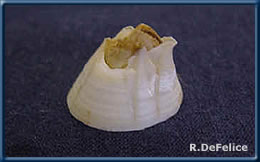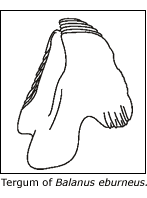

Balanus amphitrite

Balanus eburneus

Chthamalus proteus

Gonodactylaceus falcatus

Ligia exotica

Pachygrapsus fakaravensis

Scylla serrata
Balanus eburneus
 Ivory
barnacle
Ivory
barnacle
Phylum Arthropoda
Subphylum Crustacea
Class Maxillopoda
Subclass Cirripedia
Order Thoracica
Family Balanidae
Description
A small, white, conical barnacle, without the longitudinal stripes of
Balanus amphitrite and B.
reticulatus previously discussed. Large adults approach 2 cm in
diameter. Surface of the test plates generally smooth or with shallow
horizontal grooves. The tergum has a short broad spur with a rounded tip,
quite distinct from both B. amphitrite and
B. reticulatus.
 Habitat
Habitat
Common in the low intertidal fouling community. Found on ship hulls, buoys,
pilings, oysters and mangrove roots.
Distribution
Hawaiian Islands
Throughout the main islands
Native Range
Atlantic coast of North America and Caribbean to northern South America
Present Distribution
Worlwide in warm and tropical seas
Mechanism of Introduction
An early unintentional introduction, as fouling on ships' hulls
Impact
Nuisance fouling species. Ecological impact unstudied, most likely some
competition for space with other intertidal species.
Ecology
Feeding
Barnacles have specialized paired appendages, called cirri, that they
use as a scoop net, reaching out into the water and extracting food particles.
When they cirri are drawn back, food is scraped off into the mouth.
Reproduction
These barnacles are hermaphrodites, but cross-fertilization occurs in
dense populations. In such cases, males deposit sperm directly into the
mantle cavity of adjacent functional females via a long tube. Fertilized
eggs are brooded in the mantle cavity, and it may be several months before
the free-swimming planktonic larvae are released.
Remarks
This western Atlantic Ocean "ivory barnacle" was first collected
in 1929 in Pearl Harbor. Edmondson (1931) wrote that Balanus
eburneus is a typical species of the east coast of the United States,
which is suggestive of the view that the barnacle may have been transported
to Hawaii through shipments of oysters or on the bottoms of ships. Edmondson
(1933) noted that it was in Pearl Harbor, on buoys, floats, and oyster
shells. It is now abundant and has been reported throughout the main Islands.
References
Edmondson, C.H. 1931. New crustacea from Kauai, Oahu and Maui. Occ. Pap.
B.P. Bishop Mus. 9(17): 18.
Edmondson, C.H. 1933. Reef and Shore Fauna of Hawaii. B.P. Bishop Mus.
Spec. Pub. 22.
© 2002 Hawaii Biological Survey, Bishop Museum
contact